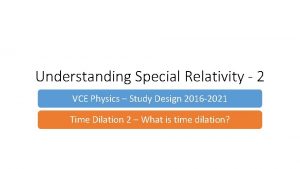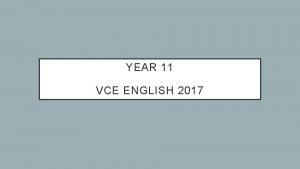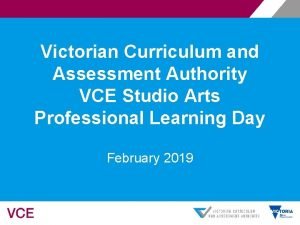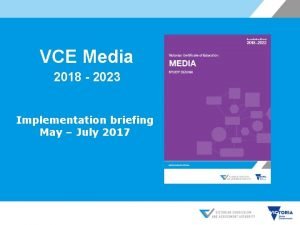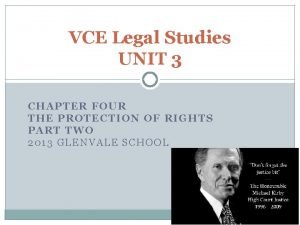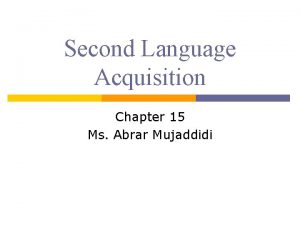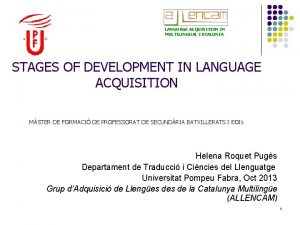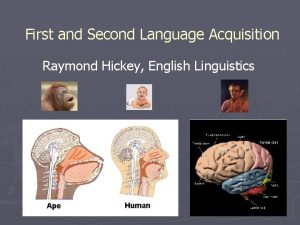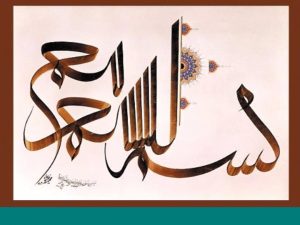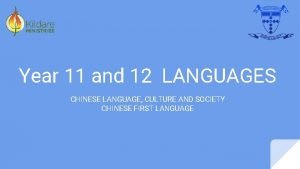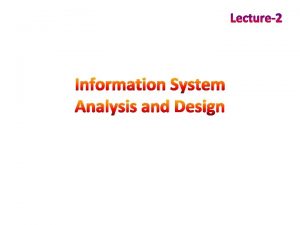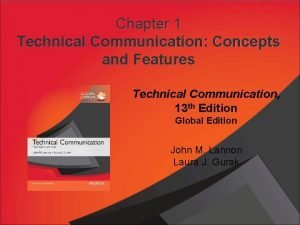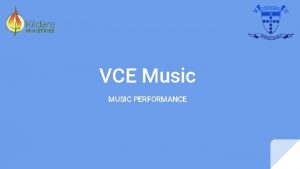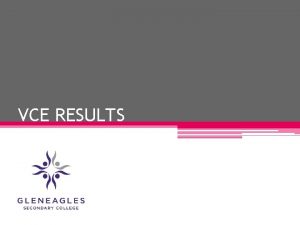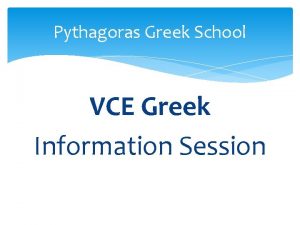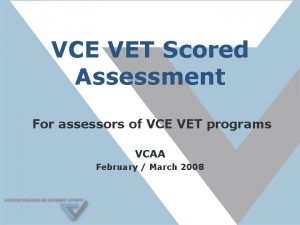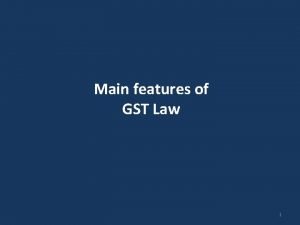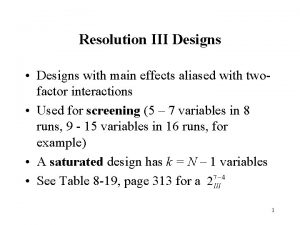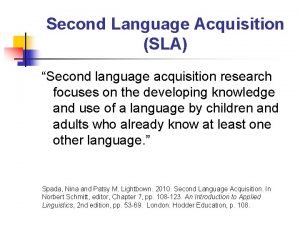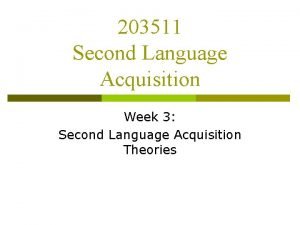Main features of VCE Second Language study designs























- Slides: 23

Main features of VCE Second Language study designs (2019 -2024) Implementation briefing

Current numbers of VCE students • Approx 54, 000 students do at least one Year 12 subject each year • In 2018 approximately 10, 748 students are studying a Language other than English at Year 12 level • Currently 50 languages are offered in the VCE

VCE Languages reviewed The Victorian Curriculum and Assessment Authority has published twelve new VCE Second Language study designs: Arabic Indonesian Second Language Chinese Second Language Advanced French German Greek Italian Japanese Second Language Korean Second Language Spanish Vietnamese Second Language

VCE Languages reviewed All twelve reviewed study designs are now available on the Victorian Curriculum and Assessment Authority website

Staged Implementation • Units 1 and 2 of the new study designs will be implemented in 2019 • Units 3 and 4 will be implemented in 2020 • The accreditation period for these studies will be 2019 -2024

Features of revised VCE Second Language studies • Online Advice for Teachers (AFT) documents will be devised for all 12 languages • The Advice for Teachers replaces the current Assessment Handbook • Exam specifications and sample SACS will no longer be in study designs

Features of revised VCE Second Language studies Entry statement in study designs: Second language studies are “designed for students who have typically studied the language for at least 200 hours prior to commencing Unit 1”

Features of revised VCE Second Language studies • Structure builds on the concepts and terminology in the Victorian Curriculum F – 10 to allow a clear transition • Viewing included as 5 th macroskill • Assessment tasks for Units 1 and 2 to be devised by the teacher • Key knowledge and key skills for each area of study are in separate lists.

School-assessed coursework Units 1 & 2 Units 3 & 4 3 assessment 3 SACs – Unit 3 tasks per unit 3 SACs – Unit 4 Schools report results Report results to the VCAA: Only S/N VCAA: S/N and marks Responses in English No SAC responses for Unit 1 Outcome 2 required in English

Features of revised VCE Second Language studies Each study design sets out • Prescribed themes and topics for the specific language and culture/s • Suggested subtopics • Text types students can be expected to produce • Styles of writing – personal, imaginative, persuasive, informative and evaluative • Grammar list

Cross-study specifications – common to all languages

Features of revised VCE Second Language studies • Students are required to study and analyse “cultural products or practices” as part of some assessment tasks and SACS. • Cultural products and practices may include: stories, poems, plays, novels, songs, films, photographs, artworks, architecture, technology, food, clothing, sports and festivals.

Three Areas of Study in each unit • Interpersonal communication • Interpretive communication • Presentational communication The outcomes for each unit reflect these.

Features of revised VCE Second Language studies In Unit 3 • Each area of study must cover a different subtopic, though teachers may choose to teach more than one subtopic in an area of study • Students participate in a role play to negotiate a solution to a personal issue • Students express ideas in personal, informative or imaginative writing

Unit 3 - Outcomes Marks Outcome 1 20 Participate in a spoken exchange to resolve a personal issue Outcome 2 Interpret information from texts and write responses 15 Outcome 3 15 Express ideas in a personal, informative or imaginative piece of writing Total marks 50 Assessment tasks A three- to four-minute role-play, focusing on negotiating a solution to a personal issue Responses to specific questions or instructions using information extracted from written, spoken and viewed texts on the selected subtopic An approximately 250 -word/200 - character (CSL)/250 -character (CSLA)/450 -ji/600 -cha personal, informative or imaginative piece of writing

Features of revised VCE Second Language studies In Unit 4 • Two SACs in Unit 4 can be on the same topic • There are three separate SACs two of which require analysis of chosen aspects of culture (and can be on the same topic) • Students produce a piece of evaluative or personal writing on an issue (SAC 3)

Unit 4 - Outcomes Marks Outcome 1 20 Share information, ideas and opinions in a spoken exchange Outcome 2 Analyse information from written, spoken and viewed texts for use in a written response 15 Outcome 3 15 Present information, concepts and ideas in evaluative or persuasive writing on an issue Total marks 50 Assessment tasks A three- to four-minute interview providing information and responding to questions about a cultural product or practice An approximately 250 -word/250 - character(CSL)/300 -character (CSLA)/450 -ji/650 -cha written response for a specific audience and purpose, incorporating information from three or more texts An approximately 300 -word/300 - character (CSL)/350 -character (CSLA)/500 -ji/700 -cha evaluative or persuasive piece of writing

Features of revised VCE Second Language studies • Chinese Second Language (CSL) and Chinese Second Language Advanced (CSLA) are in separate study designs • Character list for CSL has 440 characters • Character list for CSLA has 618 characters • No translation tasks in VCE Chinese studies • In Japanese Second Language (JSL) there is now only one list of prescribed Kanji

Advice for Teachers The online Advice for Teachers will contain: • suggested learning activities for each unit • performance descriptors for the SACs in Units 3 and 4 • detailed examples of activities on specific topics leading to an assessment task

External Exams Oral Examination approximately 15 minutes Written Examination 2 hours plus 15 minutes reading time. Sample exams will be provided for all twelve studies

For ongoing information The VCAA Bulletin provides regular updates on briefings and all other curriculum and assessment issues

Contact Details dellora. maree. r@edumail. vic. gov. au Tel: 9032 1692 dikaiou. maria. m@edumail. vic. gov. au Tel: 9032 1689 bryant. catherine. l@edumail. vic. gov. au Tel: 9032 1688

Copyright © Victorian Curriculum and Assessment Authority. Third parties may own copyright in some content included in this presentation, as indicated. The term VCE and associated logos are registered trademarks of the VCAA content may be used in accordance with the VCAA’s Intellectual Property and Copyright Policy http: //www. vcaa. vic. edu. au/Pages/aboutus/policies/policycopyright. aspx Victorian Curriculum and Assessment Authority www. vcaa. vic. edu. au
 English language study design 2021
English language study design 2021 Psychology study design
Psychology study design Outdoor and environmental studies study design
Outdoor and environmental studies study design Drama conventions vce
Drama conventions vce Physics study design
Physics study design Vce study score bell curve
Vce study score bell curve Studio arts study design
Studio arts study design Theatre technologies vce
Theatre technologies vce 2019 visual communication design exam
2019 visual communication design exam Vce media
Vce media Legal studies study design
Legal studies study design Hhd study design 2021
Hhd study design 2021 Vcaa scientific poster template
Vcaa scientific poster template Difference between second language and foreign language
Difference between second language and foreign language Difference between second language and foreign language
Difference between second language and foreign language Difference of first language and second language
Difference of first language and second language Language
Language Classification of study designs
Classification of study designs Language in life
Language in life 27 miles per gallon into kilometers per liter
27 miles per gallon into kilometers per liter Characteristics of a system in system analysis and design
Characteristics of a system in system analysis and design Characteristics of the elizabethan theatre
Characteristics of the elizabethan theatre The characteristics of qualitative research
The characteristics of qualitative research Technical communication means
Technical communication means




